 |
 |
|
 |
 |
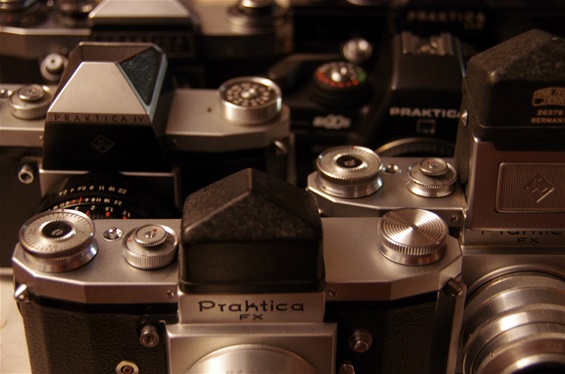 Praktica of East Germany produced low priced but solid cameras from 1949 til 1990. During that period more than 7,7 million SLR cameras were produced, more than 7,5 million being penta prism cameras. Only the biggest Japanese brands could match that number.
Praktica of East Germany produced low priced but solid cameras from 1949 til 1990. During that period more than 7,7 million SLR cameras were produced, more than 7,5 million being penta prism cameras. Only the biggest Japanese brands could match that number.
1950-1966: The first series:
In 1949 Praktica introduced their first SLR. For about one year they were all sold as waist level cameras, with a fixed finder. So, in August 1950, the first PP SLR was born. Although their main priority was waist level SLRs for many years to come,
some very small series of eye level cameras were produced in between. The first ones were simply called Praktica. The FX followed in 1952, then FX 2 and FX 3 from 1955 with fixed waist level finder, until Kamerawerke, the company behind Praktica, finally
took the consequenses of PP SLR being the future and WL SLR the past. So, in 1959, they introduced the Praktica IV with fixed penta prism. Instant Return Mirror was introduced with the Praktica V in 1964. (One must remember that Kamerawerke had produced
Praktina PP SLRs since 1952, thus offering both waist level (Praktica) and eye level (Praktina) cameras. Towards the end of the fifties the policy was changed: Praktica was to be the leading East German brand name, while Contax, Exakta and Praktina were all
tuned down, to finally disappear through the sixties.)
Prod. period: Copies produced: 1950-1952: Praktica: 62.273 Fixed WL. Only small series of PP. 1952-1957: FX:
95.206 Fixed WL. Only small series of PP. 1955-1959: FX2/FX3: 136.408 (FX3 for export). Fixed WL.From 1956 with automatic diaphragm! 1959-1964: IV: 169.763
First fixed penta prism. Automatic diaphragm. 1964-1966: V: 15.065 First IRM from East Germany.
1949-1952: Praktica 1:
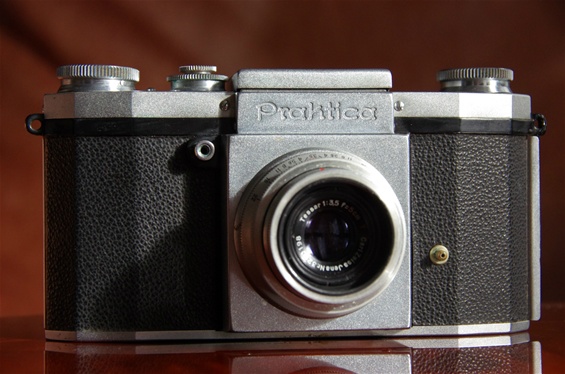 The Praktica of 1949, descendant of the famous prewar Praktiflex. This is the very first version, recognized by the black strap lugs braised on at the side. Only the first variant had these, later variants had chromed ones screwed in a bit further to the front. This first models has no black painted logo. Within every series there were different flash sockets. This early one had only one contact, an F contact for bulb, even sticking out from the body. The first year, Praktica produced only fixed waist level finders.
Size: 152x82x52mm. Weight: 621 grams. Sn. 02328.
The lens is a Carl Zeiss Jena Tessar 50/3,5. Sn. 3 260 198.
The Praktica of 1949, descendant of the famous prewar Praktiflex. This is the very first version, recognized by the black strap lugs braised on at the side. Only the first variant had these, later variants had chromed ones screwed in a bit further to the front. This first models has no black painted logo. Within every series there were different flash sockets. This early one had only one contact, an F contact for bulb, even sticking out from the body. The first year, Praktica produced only fixed waist level finders.
Size: 152x82x52mm. Weight: 621 grams. Sn. 02328.
The lens is a Carl Zeiss Jena Tessar 50/3,5. Sn. 3 260 198.
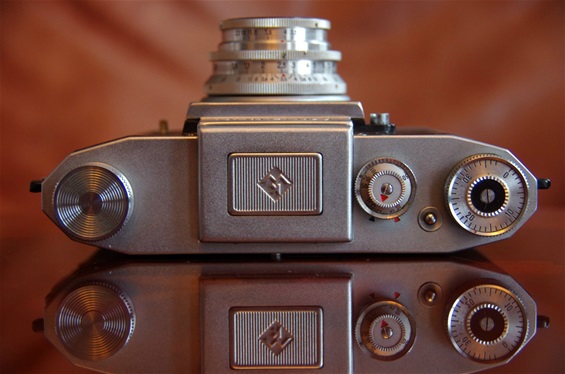 With only minor changes, this layout was to stay for some 15 years!
With only minor changes, this layout was to stay for some 15 years!
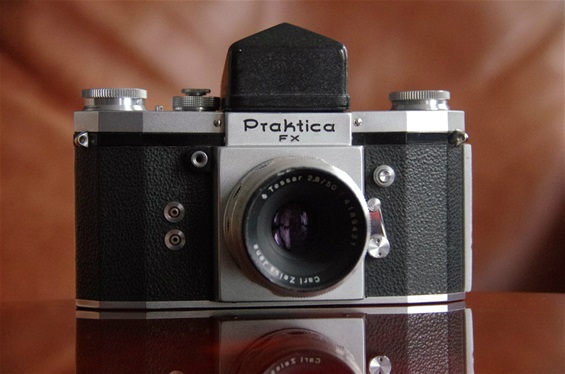 The Praktica Service Version, as the PP SLRs were called, were made in small numbers. The wast majority of the pioneer Praktica SLRs were waist level finder cameras. From 1950 on in very small series with an interchangeable finder, thus ready for a penta prism finder. The picture here shows a camera produced in 1954, but with the exact looks and technical features of the oldest one from 1950. The letters FX is the only detail that tell us the later year of production. Sn: 137436.
(The sn. to be found under the mirror, inside the camera!) F and X flash contacts on the right hand side under the small horizontal shutter release, self timer on the left, under its release button.
Only 300 were made of this very rare Service Version, some with self timer and F and X contacts, some without one or the other, or both.
The Praktica Service Version, as the PP SLRs were called, were made in small numbers. The wast majority of the pioneer Praktica SLRs were waist level finder cameras. From 1950 on in very small series with an interchangeable finder, thus ready for a penta prism finder. The picture here shows a camera produced in 1954, but with the exact looks and technical features of the oldest one from 1950. The letters FX is the only detail that tell us the later year of production. Sn: 137436.
(The sn. to be found under the mirror, inside the camera!) F and X flash contacts on the right hand side under the small horizontal shutter release, self timer on the left, under its release button.
Only 300 were made of this very rare Service Version, some with self timer and F and X contacts, some without one or the other, or both.
 Carl Zeiss Jena Tessar 50/2,8. Sn. 4 189 431.
Carl Zeiss Jena Tessar 50/2,8. Sn. 4 189 431.
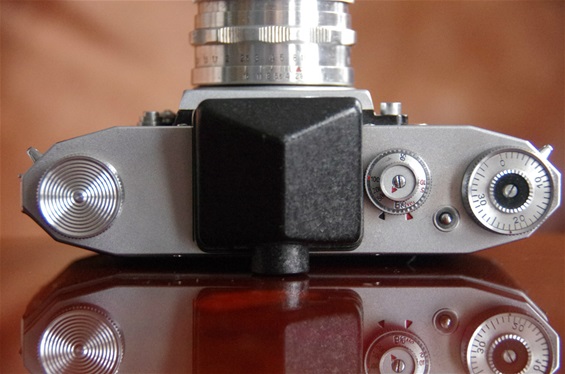 Identical in every way to the 1950 version. Winder knob and frame counter to the right, then shutter time control, and big rewind knob to the left.
Identical in every way to the 1950 version. Winder knob and frame counter to the right, then shutter time control, and big rewind knob to the left.
1952-1957: FX:
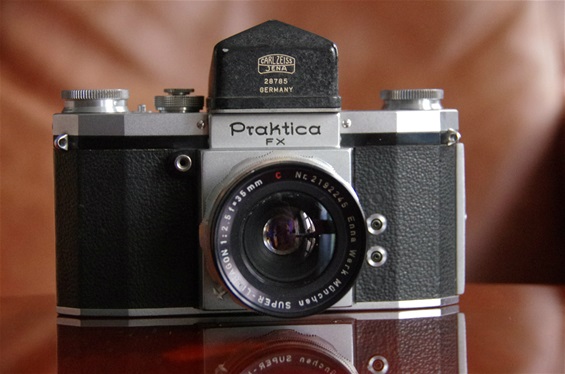 The FX series was introduced in 1952, with F and X flash sockets. This is another 1954 FX Service Version, here with Carl Zeiss Jena logo and serial number 28785 on the prism house. Two flash sockets. Camera sn: 121795.
Lens in this combo is an Enna Lithagon 35/2,5 from Enna Werk Munchen.
The FX series was introduced in 1952, with F and X flash sockets. This is another 1954 FX Service Version, here with Carl Zeiss Jena logo and serial number 28785 on the prism house. Two flash sockets. Camera sn: 121795.
Lens in this combo is an Enna Lithagon 35/2,5 from Enna Werk Munchen.
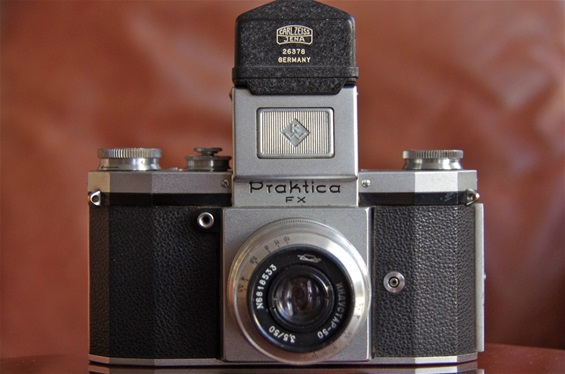 Carl Zeiss Jena made penta prism converters to simply put on top of the waist level view finder, thereby meeting the need of all those who had a fixed waist level Praktica SLR, but wanted the benefits of the superior PP SLR. This one is from 1955 and has only one flash contact. Sn. 153845.
Carl Zeiss Jena made penta prism converters to simply put on top of the waist level view finder, thereby meeting the need of all those who had a fixed waist level Praktica SLR, but wanted the benefits of the superior PP SLR. This one is from 1955 and has only one flash contact. Sn. 153845.
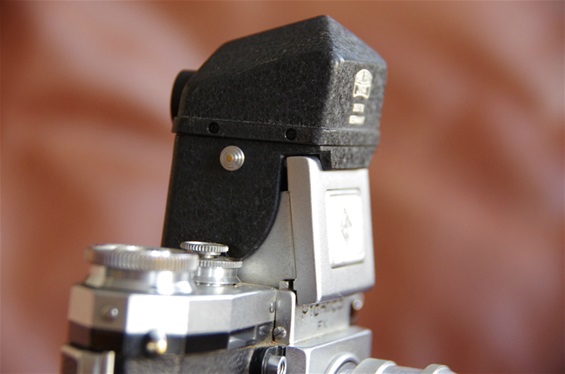 Not exactly nice, but it works!
Not exactly nice, but it works!
1959: Praktica IV:
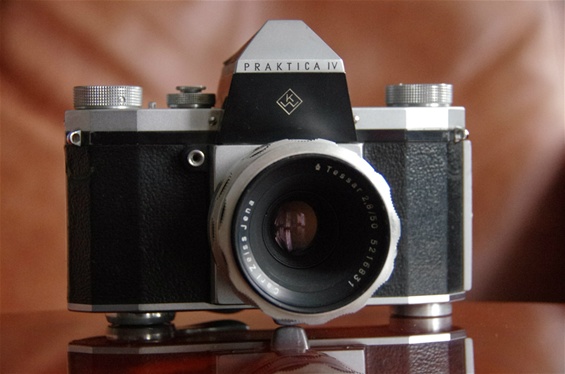 In 1959, Praktica at last produced a fixed PP SLR, the Praktica IV. The first version, like mine here, had a black lower part of the prism. Produced till 1960 and followed by models with full polished prism. Size: 152x108x47 mm. Weight: 714 grams.
Sn: 373313.
In 1959, Praktica at last produced a fixed PP SLR, the Praktica IV. The first version, like mine here, had a black lower part of the prism. Produced till 1960 and followed by models with full polished prism. Size: 152x108x47 mm. Weight: 714 grams.
Sn: 373313.
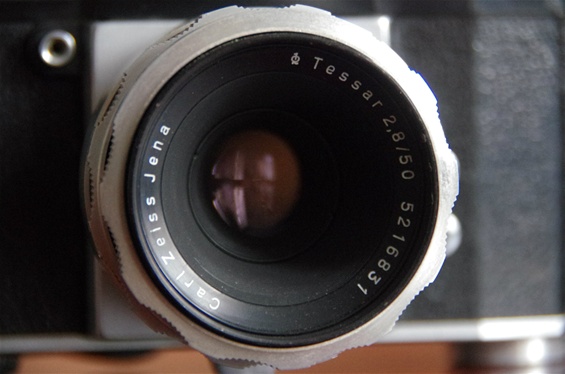 Carl Zeiss Jena Tessar 50/2,8 with connecting pin at the rear. Prakticas from 1956 (FX 2/3) had the actuator inside to match these lenses, introducing (semi) automatic diaphragm to see object at full opening and improve focusing. Sn. 5 216 831.
Carl Zeiss Jena Tessar 50/2,8 with connecting pin at the rear. Prakticas from 1956 (FX 2/3) had the actuator inside to match these lenses, introducing (semi) automatic diaphragm to see object at full opening and improve focusing. Sn. 5 216 831.
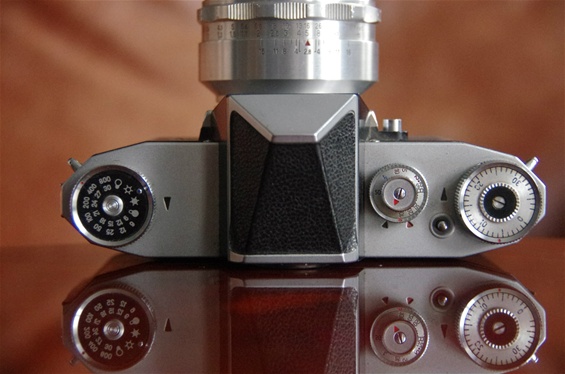 Only the ASA/DIN reminders on the rewind knob was different from the first model, ten years before. And the fixed prism house, of course.
Only the ASA/DIN reminders on the rewind knob was different from the first model, ten years before. And the fixed prism house, of course.
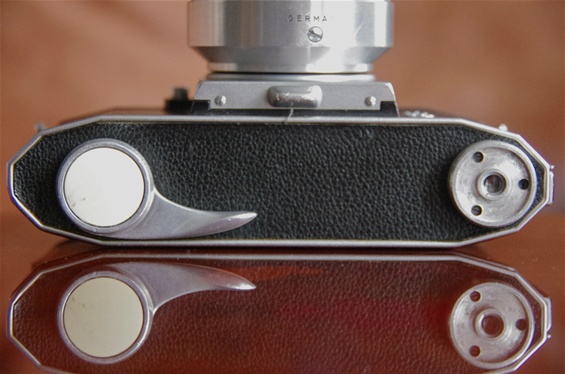 In addition to the winder knob on top, the Praktica IV featured a winder arm. Not at the top, but on the base plate! To be operated by the right arm, thereby functioning better than the Canon solution of 1959.
In addition to the winder knob on top, the Praktica IV featured a winder arm. Not at the top, but on the base plate! To be operated by the right arm, thereby functioning better than the Canon solution of 1959.
1964: Praktica V:
 The Praktica V of 1964 was the first East German PP SLR with Instant Return Mirror, IRM. Knowing that Praktiflex of late 30's, made in Dresden, introduced an IRM or RRM, it is a puzzle why Praktica had to wait until 1964 to present it again. Production of the V was started december 1964 while the first cameras were delivered early 1965. The F after V stands for Fresnell lens for brighter viewer and easier focusing. Standard on most PP SLRs since late 50s. Sn. 802767
The Praktica V of 1964 was the first East German PP SLR with Instant Return Mirror, IRM. Knowing that Praktiflex of late 30's, made in Dresden, introduced an IRM or RRM, it is a puzzle why Praktica had to wait until 1964 to present it again. Production of the V was started december 1964 while the first cameras were delivered early 1965. The F after V stands for Fresnell lens for brighter viewer and easier focusing. Standard on most PP SLRs since late 50s. Sn. 802767
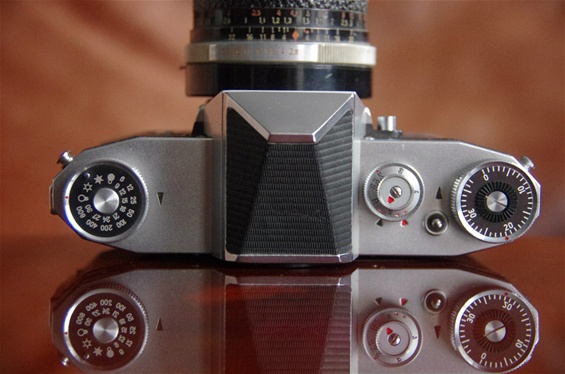 Looks almost exactly like the Praktica IV, but with three changes: first, shutter times were no longer 1/500, 1/200, 1/100, 1/50, 1/25, 1/10, 1/5, 1/2 and B, but more correct 1/500, 1/250, 1/125, 1/60, 1/30, (1/15 missing) 1/8, 1/4, 1/2 of a second. Secondly, top of winder knob had turned black, and thirdly..
Looks almost exactly like the Praktica IV, but with three changes: first, shutter times were no longer 1/500, 1/200, 1/100, 1/50, 1/25, 1/10, 1/5, 1/2 and B, but more correct 1/500, 1/250, 1/125, 1/60, 1/30, (1/15 missing) 1/8, 1/4, 1/2 of a second. Secondly, top of winder knob had turned black, and thirdly..
 the rewind knob could be split into two individually rotating cylinders, making rewinding faster. A step on the way to a foldable rewind crank.
the rewind knob could be split into two individually rotating cylinders, making rewinding faster. A step on the way to a foldable rewind crank.
1965-1969: Nova Series:
Praktica marked the new period as from the first Nova in 1965, introducing many new features: Prakticas first top mounted winder arm, rewind crank ++. And not the least: the TTL metering that came with Praktica Mat, among the earliest worldwide to introduce
this.
The Nova series: Copies
1965-1969: Nova. 42.915
1965-1969: Praktica Mat. 25.245 First Through The Lens metering Praktica.
1965-1967: Nova
B: 100.242
1967-1969: Pentaflex SL: 50.174 Total series: 263 811
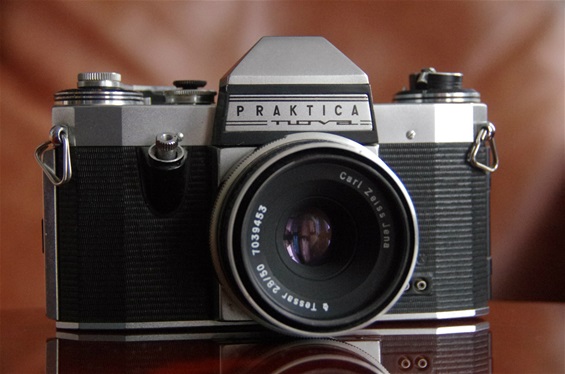 To introduce the new series in 1965: the Nova. Prakticas first: top mounted winder arm, foldable rewind crank, 45 degrees shutter release button and a modern look. The Instant Return Mirror was inherited from its predecessor, the Praktica V. The only feature remaining from the old style was the shutter time dial, still spinning during exposure. But that was soon to change.
Sn. 147651.
To introduce the new series in 1965: the Nova. Prakticas first: top mounted winder arm, foldable rewind crank, 45 degrees shutter release button and a modern look. The Instant Return Mirror was inherited from its predecessor, the Praktica V. The only feature remaining from the old style was the shutter time dial, still spinning during exposure. But that was soon to change.
Sn. 147651.
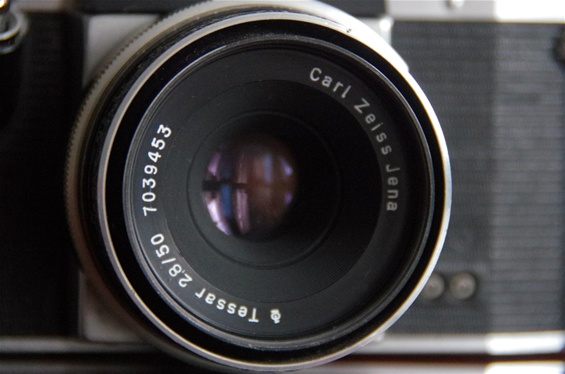 Carl Zeiss Jena Tessar 50/2,8. New design. Sn. 7 039 453.
Carl Zeiss Jena Tessar 50/2,8. New design. Sn. 7 039 453.
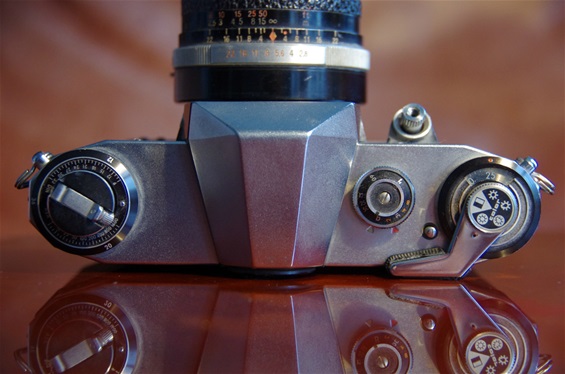 With the Nova, Praktica presented a modern look with top mounted winder arm and foldable rewind crank. But still the time setting dial was rotating!
With the Nova, Praktica presented a modern look with top mounted winder arm and foldable rewind crank. But still the time setting dial was rotating!
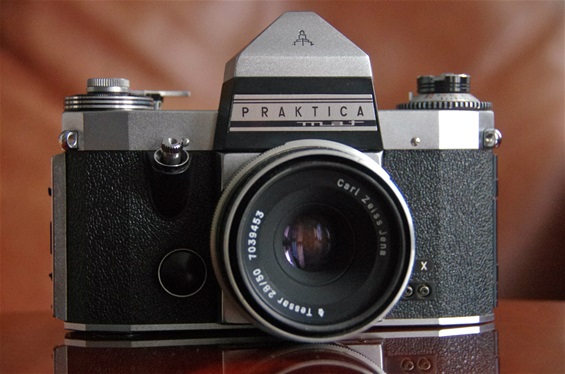 The Praktica Mat of 1965 was their first with TTL metering - light metering Through The Lens. Pushing the big black button on the front wall would give the reading in the viewer: an arrow would point out over/under exposure. Size: 153x105x47 mm. Weight: 692 grams. Sn. 20075.
The Praktica Mat of 1965 was their first with TTL metering - light metering Through The Lens. Pushing the big black button on the front wall would give the reading in the viewer: an arrow would point out over/under exposure. Size: 153x105x47 mm. Weight: 692 grams. Sn. 20075.
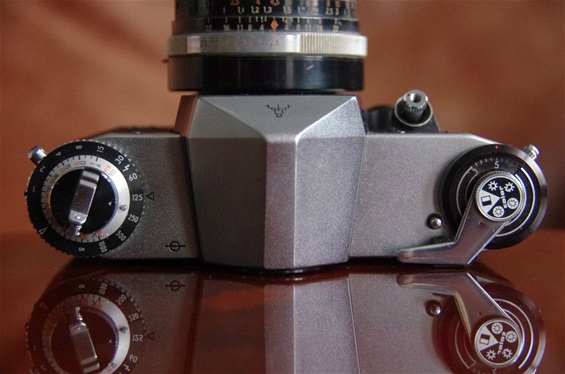 The Praktica mat featured not only their first TTL, but also their first non rotating shutter time dial. Contrary to all other models it was placed at the left side of the top plate.
Lens was either this Tessar like on the Nova, or the zebra type, like on the following Super TL, depending on production year.
The Praktica mat featured not only their first TTL, but also their first non rotating shutter time dial. Contrary to all other models it was placed at the left side of the top plate.
Lens was either this Tessar like on the Nova, or the zebra type, like on the following Super TL, depending on production year.
1967-1976: PL Nova series:
The PL Nova series introduced the Praktica (film) Load system, hence the name PL. 1967-1972: PL Nova I: 136.400
1968-1969: PL Electronic: 3.399
1968-1976: Super TL:
508.656 An internatioanal mass seller from Praktica. Total series: 837 050.
 The Super TL was a success, not only in the eastern bloc. It was known as a workhorse, modern but not technologically leading. Besides, it was among the less expensive cameras you could find. It took over after the Praktica Mat as the TTL camera. Light was metered by pushing the big, black button under shutter release button. Size: 154x99x53mm. Weight: 628 gr. Sn: 108057.
The Super TL was a success, not only in the eastern bloc. It was known as a workhorse, modern but not technologically leading. Besides, it was among the less expensive cameras you could find. It took over after the Praktica Mat as the TTL camera. Light was metered by pushing the big, black button under shutter release button. Size: 154x99x53mm. Weight: 628 gr. Sn: 108057.
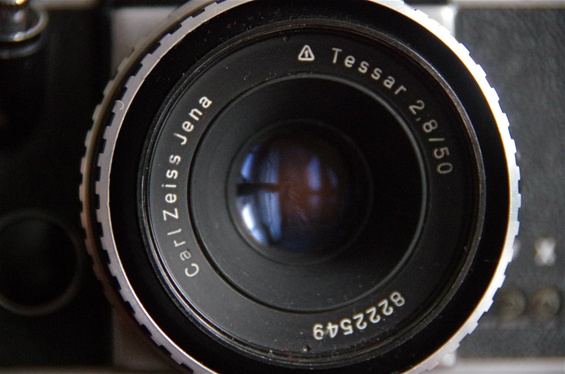 Yet another design on the Carl Zeiss Jena Tessar 50/2,8, the zebra look that was very common on german (and some very few japanese) lenses during late 50s and through the 60s.
Sn. 8 222 549.
Yet another design on the Carl Zeiss Jena Tessar 50/2,8, the zebra look that was very common on german (and some very few japanese) lenses during late 50s and through the 60s.
Sn. 8 222 549.
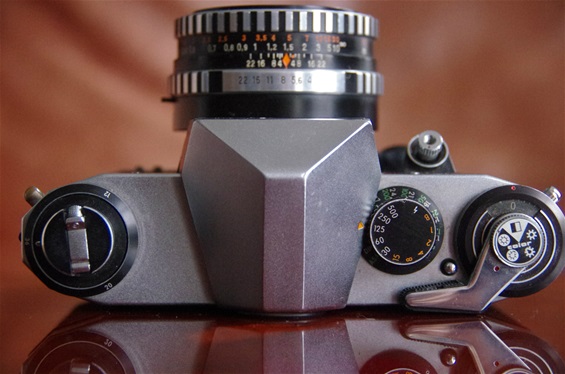 The frame counter had been moved forwards and, at last: the shutter time dial had been moved back to the usual position, still non rotating as on the Praktica mat. Note the zebra design of the lens.
The frame counter had been moved forwards and, at last: the shutter time dial had been moved back to the usual position, still non rotating as on the Praktica mat. Note the zebra design of the lens.
1969-1978: L-series, first generation:
The Praktica success went on as they introduced the L series in 1969, feauturing a metal blade vertical shutter. A world first was obtained in 1969 with the electronic aperture simulation. This was an important step forwards, and soon followed by japanese
makers. Through the Nova- and further on during the L-series, production was modernized to a point where Pentacon Dresden produced a new camera every 30 second. 1969-1975: L: 278.731 Non metered
1969-1975: LLC: 176.697 Worlds first electronic aperture simulation
1970-1975: LTL: 373.490 Stop down, non electronic metering. 1/1000
1972-1977: LB:
121.228 Non TTL. Non coupled cds meter.
1975-1975: VLC Motor: 6.000 Special Model
1975-1978: LTL 2: 15.010 Continuation
of LTL, minor differences.
1975-1978: Super TL2: 129.626 Continuation of Super TL, but 1/1000 shutter.
1975-1978: Praktica 1000: ? Very rare edition av LTL 2.
1976-1976: TL:
? Very rare. 1/500.
Total series: 1 110 357
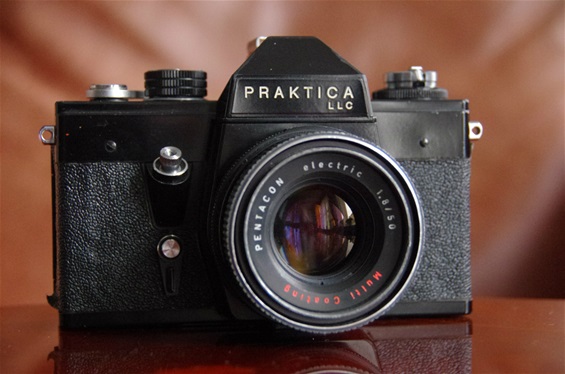 A world first for Praktica: the LLC of 1969 with electronic contacts on body and lens to transmit information. Not easy, or common, on a M42 screw mount.
Sn: 351814
A world first for Praktica: the LLC of 1969 with electronic contacts on body and lens to transmit information. Not easy, or common, on a M42 screw mount.
Sn: 351814
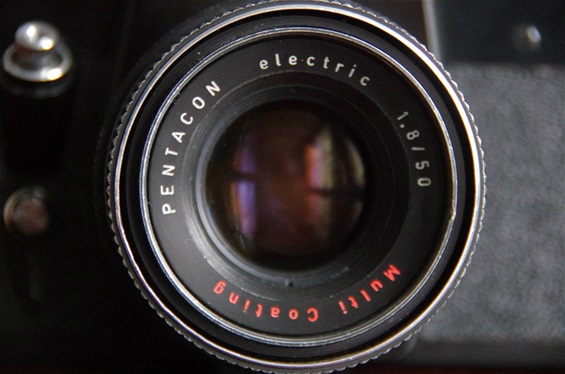 This was the first lens for a fully electric connection to the camera. Besides, it had a 1,8 opening and Multi Coating!
And the name was Pentacon, telling us it was produced at Meyer Görlitz, formerly independent, but from 1970 part of Pentacon.
Sn. 7 926 039.
This was the first lens for a fully electric connection to the camera. Besides, it had a 1,8 opening and Multi Coating!
And the name was Pentacon, telling us it was produced at Meyer Görlitz, formerly independent, but from 1970 part of Pentacon.
Sn. 7 926 039.
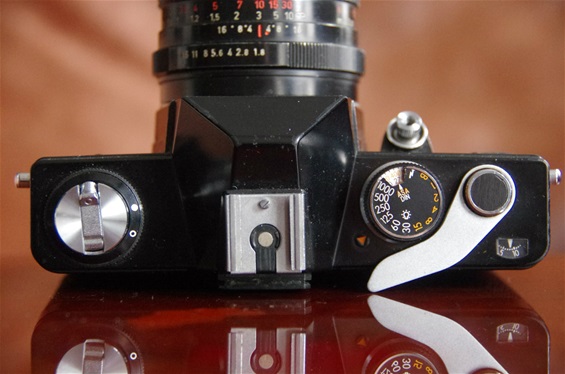 Frame counter moved to the rear again, plus a new winder mechanism and arm with a short and effective stroke.
Frame counter moved to the rear again, plus a new winder mechanism and arm with a short and effective stroke.
1975-1980: L-series, second generation:
The second generation of the L-series was produced almost parallell to the last part of the 1. generation, from 1975 till 1980. It featured a new winder with plastic end, multi coated lenses and some new labelling. 1975-1978: LTL 3:
349 919. New winder. 1/1000.
1975-1978: PLC 2: 63 957. Electronic as LLC. 1/000.
1975-1978: L 2: 161 240. No meter.
1976-1977: LB 2: 64 984. As
LB but 1/1000.
1976-1978: VLC 2: 39 960. With interchangeable finder. First since FX series.
1977-1979: EE 2: 59 907. Electronic at full opening. First.
1978-1979: DTL 2:
158. Led lights in finder and on top plate. Stopped due to 3rd gener. Total series: 740 152
 Representing L, second generation: the EE2. The first to measure light electronically at full opening. Both manual and automatic exposure. Size: 144x98x49. Weight: 620 grams.
Sn. 065443.
Representing L, second generation: the EE2. The first to measure light electronically at full opening. Both manual and automatic exposure. Size: 144x98x49. Weight: 620 grams.
Sn. 065443.
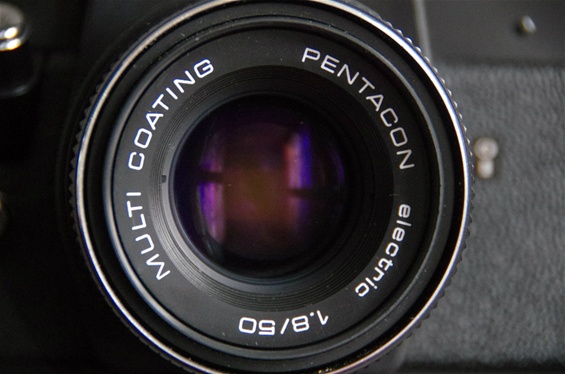 Same lens as on the LLC, but a bit different design.
Sn. 8 921 223.
Same lens as on the LLC, but a bit different design.
Sn. 8 921 223.
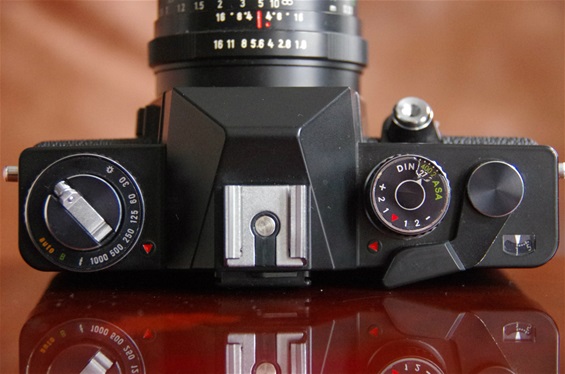 Time setting around the rewinder, B, 1/30 to 1/1000 for manual mode + Auto mode. Over/under exposure settings where the time setting usually would be found.
Time setting around the rewinder, B, 1/30 to 1/1000 for manual mode + Auto mode. Over/under exposure settings where the time setting usually would be found.
1978-1984: L-series, third generation:
Praktica introduced their third generation L-series in 1978. But only one year later they launched a quite new series with a bayonet mount, thus following Pentax, but four years later. Still Praktica was to produce M42 mount cameras for many years
to come, and with great success: the MTL 3 (1978-84) was to be their biggest single model hit ever, with 865 000 copies sold. 1978-1980: Super TL 3: 99 992. TTL stop down. 1/500.
1978-1984: MTL 3:
865 395. TTL stop down. 1/1000.
1978-1983: PLC 3: 129 958. Last electronic L version.
1978-1981: VLC 3: 30 102. Interchangeable finder.
1979-1980:
EE 3: 30 542. Electronic stepless shutter.
1979-1982: DTL 3: 35 853.
Total series: 1.119.642.
 The mass seller of the third L-generation was the MTL 3. It sold as many as 865 395 copies. TTL stop down with shutter speed 1/1000. A robust, well working camera. Size: 143x98x49 mm. Weight: 581 grams. Sn. 547172.
The mass seller of the third L-generation was the MTL 3. It sold as many as 865 395 copies. TTL stop down with shutter speed 1/1000. A robust, well working camera. Size: 143x98x49 mm. Weight: 581 grams. Sn. 547172.
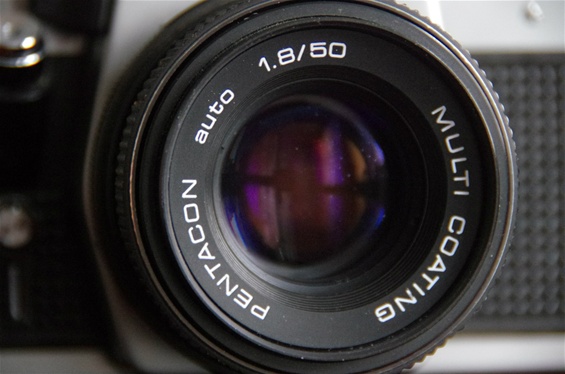 Pentacon Auto (still stop down) multi coated lens.
Sn. 9 024 938.
Pentacon Auto (still stop down) multi coated lens.
Sn. 9 024 938.
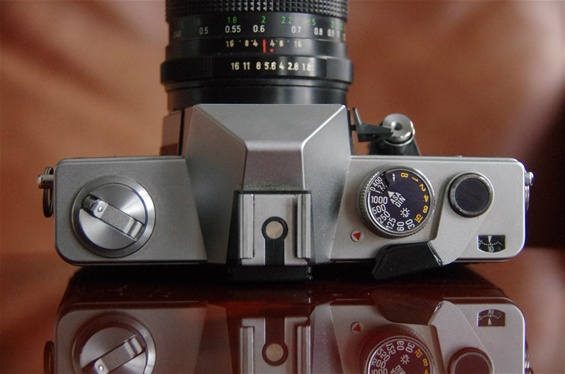 Much like the second generation, but with a redesigned winder arm, and a depth of field/light metering handle right above the trigger.
Much like the second generation, but with a redesigned winder arm, and a depth of field/light metering handle right above the trigger.
1980-1989: L-series, fourth generation:
The fourth and last of the L-series was introduced one year after the introduction of the bayonet mount. While all electronic cameras were moved to the B series, the continuing L cameras were all stop down TTLs. The production went on parallel to the
B-series and were selling considerably more than the new mount. The MTL 5/5B sold some 1.150 million copies! They were half brothers to the earlier success MTL 3, with only minor changes, and added together these three cameras sold in a number of over 2 million
pieces! 1980-1984: Super TL 1000: 318 637. A freshed up Super TL, almost identical to the MTL 3.
1981-1981: Super TL 500: 5 992: As above, but 1/500
1983-1985: MTL 5:
574 252: A continuation of the MTL 3 with smooth leatherette
1985-1989: MTL 5B: 567 831. Improved viewfinder. Selftimer. Incl.TL5B for UK.
1985-1989:
MTL 50: 229 917. New batterysystem: 4LR44/PX28 6 V. Selftimer. Total series: 1.794.728
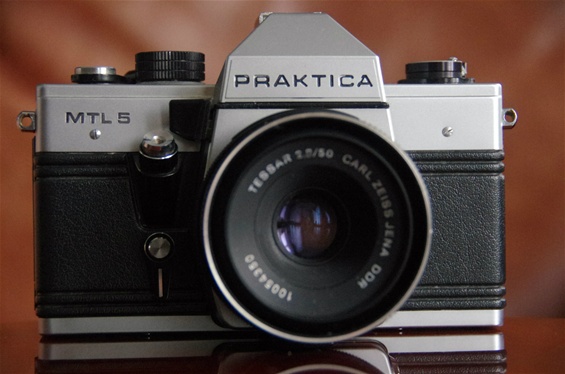 Praktica MTL 5 was following the MTL 3 and the LTL series before that, representing Prakticas most successful series. Stop down metering, non electronic. They were workhorses, easy to work with if you knew what is important and what is not. The MTL 5 differed from the 3 only by the smooth leatherette, lowering the weight by 10 grams. Size: 143x98x49. Weight: 571 grams. Sn. 1382534.
Praktica MTL 5 was following the MTL 3 and the LTL series before that, representing Prakticas most successful series. Stop down metering, non electronic. They were workhorses, easy to work with if you knew what is important and what is not. The MTL 5 differed from the 3 only by the smooth leatherette, lowering the weight by 10 grams. Size: 143x98x49. Weight: 571 grams. Sn. 1382534.
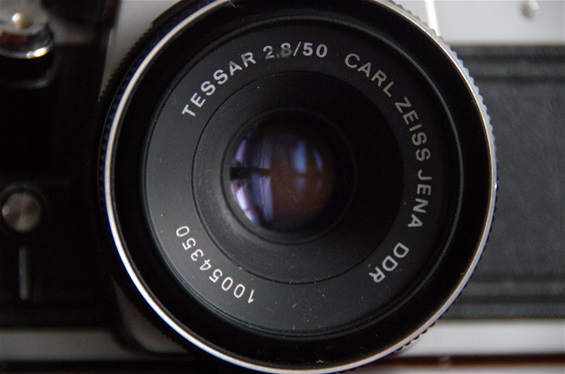 A simpler lens than on the previous ones: 50/2,8 Carl Zeiss Jena DDR marked with sn. 10 054 350.
A simpler lens than on the previous ones: 50/2,8 Carl Zeiss Jena DDR marked with sn. 10 054 350.
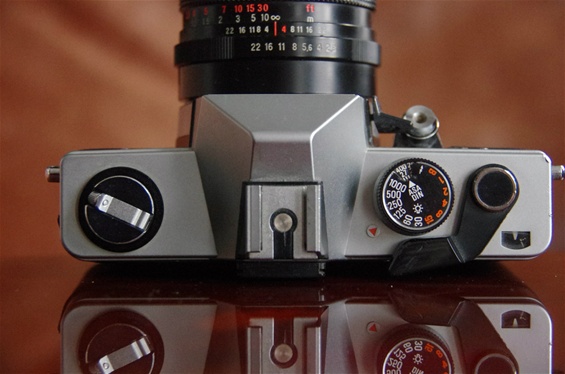 Exactly like the MTL 3, except from the black color on winder and rewinder.
Exactly like the MTL 3, except from the black color on winder and rewinder.
1979-1990: B-series:
The Praktica bayonet was introduced in 1979 and the new series was called the B-series.
The production at the main factory in Dresden went on until East Germany became a part of the new Germany and all state owned property in the east was
sold or handed over to private owners. During these last years there were three parallel series, or five if one includes the last part of L-2 and the new BX. All together, the sales of these different Prakticas reached well over 4 million copies. They were
recognized as strong and well working rather up to date cameras, costing less than the competition. Their market share in the eastern Europe was of course unthreatened, but even in the western Europe the share was substantial. Great Britain and The Netherlands
were countries were the sales were high, with market shares up to some 35%!
In addition to the bayonet, the B-series introduced more compact sizes with improved ergonomics together with fully electronic shutter and aperture. 1979-1982: B 200:
110 262. Automat+manual.
1983-1984: BC X: 69 500. As above. Export model for Great Britain.
1984-1985: Bc 1 1: 91 500. As above + exposure compensation.
1985-1988: BC
1 2: 223 129. As above. 2. version.
1987-1988: BC 3: Included. As above
1981-1986: B 100: 240 143. Automat only. 1st and 2. version.
1986-1989: BC A: 231 806. As
above + improved display.
1989-1989: BC A M: 3.535. For microscope.
1989-1990: BC S: 34 462. No auto exposure compensation.
1989-1989: BC C: 14 916. As
above, but no stop down key.
1989-1990: BM S: 137 561. Manually set shutter speed.
1989-1990: BM: 11 428. As above, but no self timer. Total series:
1 168 242.
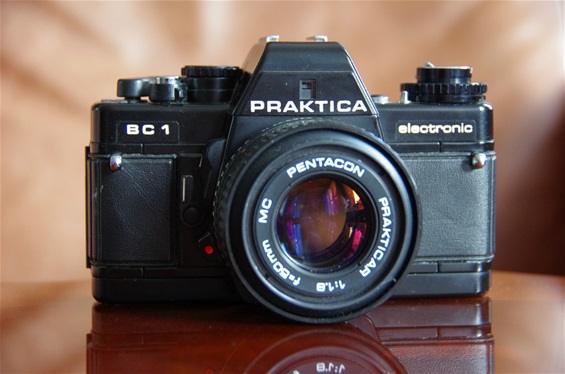 Representing the new bayonet series, the BC 1. The B series consisted of two fully automatic cameras, one fully manual and two with both. The BC 1, introduced in 1984, had both. It followed the BC 200 of 1979 and was the top of the line. It was only produced for one year, though. From 1984 till the end in 1990, only fully automats or manuals were produced as the BX line was produced from 1987. The BC 1 works well, it has stepless shutter times on automatic and is prepared for winder.
Size: 141x89x50 mm. Weight: 529 grams. Sn.: 4481794.
Representing the new bayonet series, the BC 1. The B series consisted of two fully automatic cameras, one fully manual and two with both. The BC 1, introduced in 1984, had both. It followed the BC 200 of 1979 and was the top of the line. It was only produced for one year, though. From 1984 till the end in 1990, only fully automats or manuals were produced as the BX line was produced from 1987. The BC 1 works well, it has stepless shutter times on automatic and is prepared for winder.
Size: 141x89x50 mm. Weight: 529 grams. Sn.: 4481794.
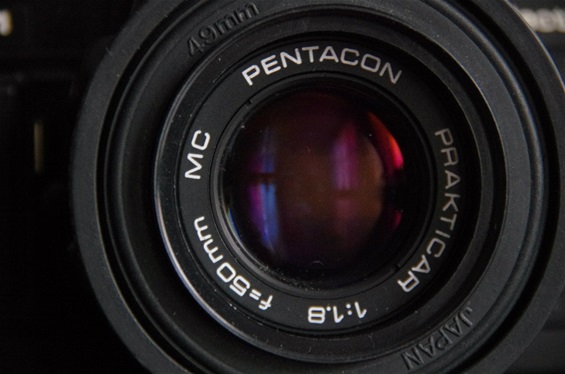 After long struggles with the western part of the company: no Carl Zeiss Jena on the lens, but Pentacon Prakticar. Sn. 4620332
After long struggles with the western part of the company: no Carl Zeiss Jena on the lens, but Pentacon Prakticar. Sn. 4620332
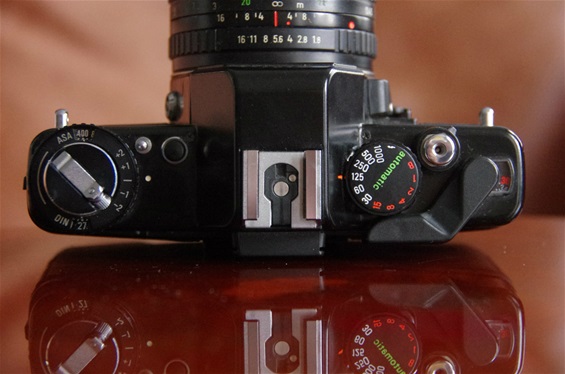 Classic layout. The silver button at the left side is a release button for the over/under exposure dial. The black one beside it has two functions: either a battery check or a lock mechanism to store light metering values. Kind of like modern AE-L button, but with no time limit and without the need to keep it pressed in. The camera remembers the values until next exposure. Neat! Camera is fully dependant on a battery to work. Without it, the shutter fires, but only at some 1/60 or 1/125, according to the sound. Wonderfully short and distinct winder travel, as it has been since the first L in 1969.
Classic layout. The silver button at the left side is a release button for the over/under exposure dial. The black one beside it has two functions: either a battery check or a lock mechanism to store light metering values. Kind of like modern AE-L button, but with no time limit and without the need to keep it pressed in. The camera remembers the values until next exposure. Neat! Camera is fully dependant on a battery to work. Without it, the shutter fires, but only at some 1/60 or 1/125, according to the sound. Wonderfully short and distinct winder travel, as it has been since the first L in 1969.
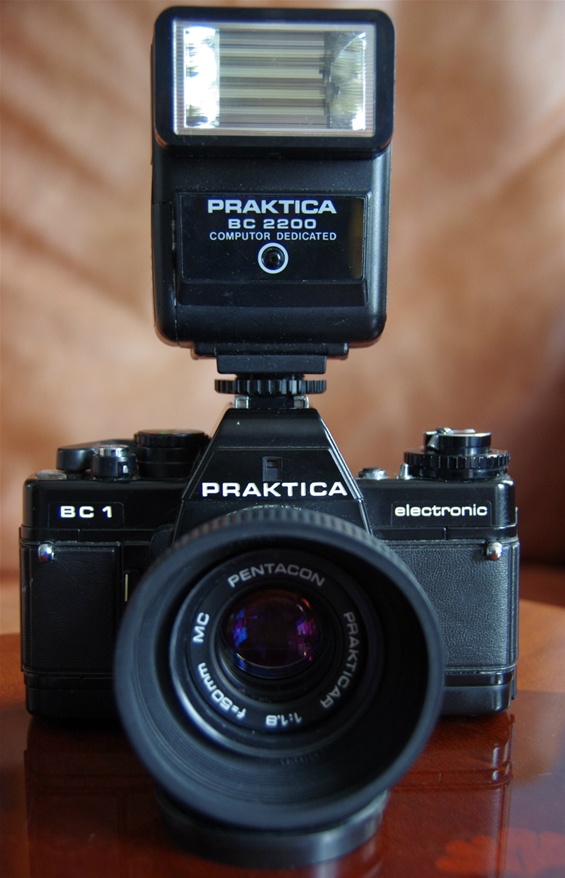 With Praktica flash 2200 and rubber hood.
With Praktica flash 2200 and rubber hood.
1987-2001: BX series:
BX series was the last Prakticas to be sold. Four models were made, but only the BX 20 was set into mass production. The new series introduced a TTL flash mode, an improved shutter, the ability to read the new DX coding on modern films, and a new and
improved ergonomic house. 1987-1990: BX 20: 201 243 New winder, improved shutter.
1989-1990: BX 10 DX: 488 Preseries, produced June-July. Economy model. DX system
1990-1990:
BX 21 DX: 29 Preseries, produced March. TTL flash. DX system 25-5000ASA.
1990-1990: BX 20s: 37 Last development. Dresden Praktica factory closes in 1990.
Total series produced in Dresden: 201.797 1991-2001: BX 20s: 33 319 Exactly like the Dresden modell. Last series production.
Produced at Schneider GMBH in West-Germany. Total series: 235.116 Total of
bayonet series: 1.403.358
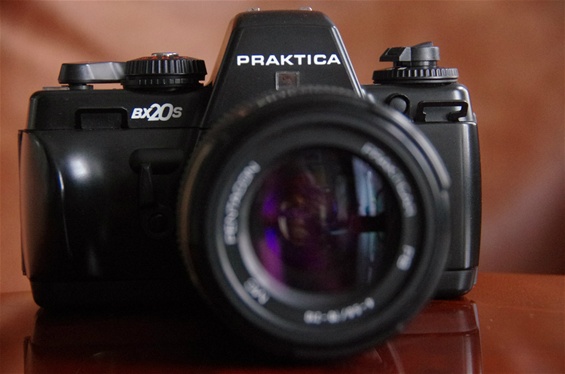 The BX 20s was the last Praktica to be built by Praktica in Dresden. Only 37 copies were made of this model, between july and august 1990. However, exactly the same camera was made by Schneider FWT GMBH until 2001 (renamed Pentacon Gmbh from 1998!!), after the closing of the original Praktica factory. Serial number indicates that this is the post East Germany version, produced in april 1994. Size: 145x92x50 mm. Weight: 497 grams. Sn. 4045243. The last camera wearing the proud Praktica name.
The BX 20s was the last Praktica to be built by Praktica in Dresden. Only 37 copies were made of this model, between july and august 1990. However, exactly the same camera was made by Schneider FWT GMBH until 2001 (renamed Pentacon Gmbh from 1998!!), after the closing of the original Praktica factory. Serial number indicates that this is the post East Germany version, produced in april 1994. Size: 145x92x50 mm. Weight: 497 grams. Sn. 4045243. The last camera wearing the proud Praktica name.
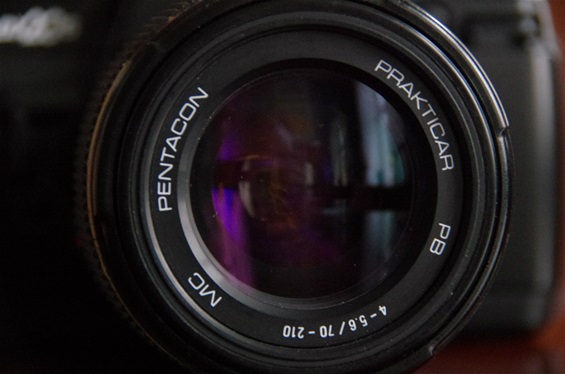 Now, here comes something strange: A Pentacon Prakticar zoom 4-5,6 70-210 MC lens. VERY much like the Sigma from the same era. There is no "Made in Germany" or "DDR" on it, but an almost hidden "Made in Japan"! So, yes, it IS a Sigma. Sn. 1 069 597.
Now, here comes something strange: A Pentacon Prakticar zoom 4-5,6 70-210 MC lens. VERY much like the Sigma from the same era. There is no "Made in Germany" or "DDR" on it, but an almost hidden "Made in Japan"! So, yes, it IS a Sigma. Sn. 1 069 597.
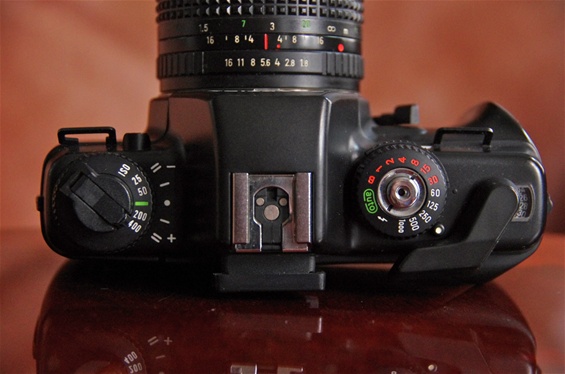 A new ergonomic house with a very plastic feeling. The winder feels fragile, like it would break. It calls for a BX winder!
As the last Praktica branded camera was produced, all other major camera factories were in the process of producing digital cameras. The Schneider factory probably never entered that process, and the once so proud Praktika brand was finally history.
A new ergonomic house with a very plastic feeling. The winder feels fragile, like it would break. It calls for a BX winder!
As the last Praktica branded camera was produced, all other major camera factories were in the process of producing digital cameras. The Schneider factory probably never entered that process, and the once so proud Praktika brand was finally history.
|
|
 |
|
|
|